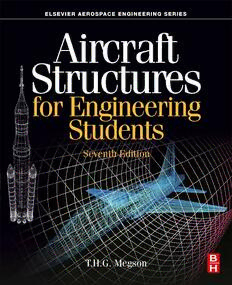
Aircraft Structures for Engineering Students , Seventh Edition [7th Ed] (Instructor's Edu Resource 1 of 2, Instructor's Solution Manual) (Solutions) PDF
Preview Aircraft Structures for Engineering Students , Seventh Edition [7th Ed] (Instructor's Edu Resource 1 of 2, Instructor's Solution Manual) (Solutions)
Aircraft Structures for Engineering Students Seventh Edition Solutions Manual T. H. G. Megson Solutions Manual Solutions to Chapter 1 Problems S.1.1 The principal stresses are given directly by Eqs (1.11) and (1.12) in which σ ¼80N/mm2, σ ¼0 x y (or vice versa), and τ ¼45N/mm2.Thus,from Eq. (1.11), xy pffiffiffiffiffiffiffiffiffiffiffiffiffiffiffiffiffiffiffiffiffiffiffiffiffiffi 80 1 σ ¼ + 802+4(cid:2)452 I 2 2 i.e., σ ¼100:2N=mm2 I From Eq.(1.12), pffiffiffiffiffiffiffiffiffiffiffiffiffiffiffiffiffiffiffiffiffiffiffiffiffiffi 80 1 σ ¼ (cid:3) 802+4(cid:2)452 II 2 2 i.e., σ ¼(cid:3)20:2N=mm2 II ThedirectionsoftheprincipalstressesaredefinedbytheangleθinFig.1.8(b)inwhichθisgivenby Eq.(1.10).Hence, 2(cid:2)45 tan2θ¼ ¼1:125 80(cid:3)0 which gives θ¼24°110 and θ¼114°110 ItisclearfromthederivationofEqs(1.11)and(1.12)thatthefirstvalueofθcorrespondstoσ whilethe I second value correspondsto σ . II Finally, the maximum shear stress is obtained from either of Eqs (1.14) or (1.15). Hence from Eq.(1.15), 100:2(cid:3)ð(cid:3)20:2Þ τ ¼ ¼60:2N=mm2 max 2 and will act onplanes at 45°tothe principal planes. S.1.2 The principal stresses are given directly by Eqs (1.11) and (1.12) in which σ ¼50N/mm2, x σ ¼–35N/mm2,andτ ¼40N/mm2.Thus,fromEq.(1.11), y xy 3 4 Solutions Manual qffiffiffiffiffiffiffiffiffiffiffiffiffiffiffiffiffiffiffiffiffiffiffiffiffiffiffiffiffiffiffiffiffiffiffiffiffiffi 50(cid:3)35 1 σ ¼ + ð50+35Þ2+4(cid:2)402 I 2 2 i.e., σ ¼65:9N=mm2 I and fromEq.(1.12), qffiffiffiffiffiffiffiffiffiffiffiffiffiffiffiffiffiffiffiffiffiffiffiffiffiffiffiffiffiffiffiffiffiffiffiffiffiffi 50(cid:3)35 1 σ ¼ (cid:3) ð50+35Þ2+4(cid:2)402 II 2 2 i.e., σ ¼(cid:3)50:9N=mm2 II From Fig. 1.8(b) and Eq. (1.10), 2(cid:2)40 tan2θ¼ ¼0:941 50+35 which gives θ¼21°380ðσÞ and θ¼111°380ðσ Þ I II Theplanesonwhichthereisnodirectstressmaybefoundbyconsideringthetriangularelementofunit thicknessshowninFig.S.1.2wheretheplaneACrepresentstheplaneonwhichthereisnodirectstress. For equilibrium ofthe element ina directionperpendicular toAC, 0¼50ABcosα(cid:3)35BCsinα+40ABsinα+40BCcosα (i) Dividingthrough Eq. (i) byAB, 0¼50cosα(cid:3)35tanαsinα+40sinα+40tanαcosα which, dividing throughby cos α, simplifiesto 0¼50(cid:3)35tan2α+80tanα FIG.S.1.2 Solutions to Chapter 1 Problems 5 from which tanα¼2:797 or (cid:3)0:511 Hence, α¼70°210 or (cid:3)27°50 S.1.3 The construction of Mohr’s circle for each stress combination follows the procedure described in Section1.8 andis shown inFigs S.1.3(a)–(d). FIG.S.1.3(a) FIG.S.1.3(b) FIG.S.1.3(c) 6 Solutions Manual FIG.S.1.3(d) S.1.4 Theprincipalstressesatthepointaredetermined,asindicatedinthequestion,bytransformingeach stateofstressintoaσ ,σ ,τ stresssystem.Clearly,inthefirstcase,σ ¼0,σ ¼10N/mm2,τ ¼0 x y xy x y xy (Fig.S.1.4(a)).Thetworemainingcasesaretransformedbyconsideringtheequilibriumofthetrian- gularelementABCinFigsS.1.4(b),(c),(e),and(f).Thus,usingthemethoddescribedinSection1.6 andtheprincipleofsuperposition(seeSection5.9),thesecondstresssystemofFigsS.1.4(b)and(c) becomestheσ ,σ ,τ systemshowninFig.S.1.4(d)whilethethirdstresssystemofFigsS.1.4(e)and x y xy (f) transformsinto the σ ,σ , τ system of Fig.S.1.4(g). x y xy Finally,thestatesofstressshowninFigsS.1.4(a),(d),and(g)aresuperimposedtogivethestateof stress shown in Fig. S.1.4(h) from which it can be seen that σ ¼σ ¼15N/mm2 and that the x and I II y planes are principal planes. FIG.S.1.4(a) Solutions to Chapter 1 Problems 7 FIG.S.1.4(b) FIG.S.1.4(c) FIG.S.1.4(d) 8 Solutions Manual FIG.S.1.4(e) FIG.S.1.4(f) FIG.S.1.4(g) Solutions to Chapter 1 Problems 9 FIG.S.1.4(h) FIG.S.1.5 S.1.5 ThegeometryofMohr’scircleofstressisshowninFig.S.1.5inwhichthecircleisconstructedusing the method described inSection 1.8. From Fig. S.1.5, σ ¼OP ¼OB(cid:3)BC+CP (i) x 1 1 IqnffiffiffiEffiffiffiqffiffiffi.ffiffiffiffiffi(ffiiffiffi)ffiffiffiffiffiOffiffi B¼qσffiffiIffiffi,ffiffiffiffiffiBffiffiffiCffiffiffiffiffiffiffiis the radius of the circle that is equal to τmax and CP1¼ CQ2(cid:3)Q P2¼ τ2 (cid:3)τ2 . Hence, 1 1 1 max xy qffiffiffiffiffiffiffiffiffiffiffiffiffiffiffiffiffiffiffi σ ¼σ (cid:3)τ + τ2 (cid:3)τ2 x 1 max max xy Similarly, σ ¼OP ¼OB(cid:3)BC(cid:3)CP inwhichCP ¼CP y 2 2 2 1 Thus, qffiffiffiffiffiffiffiffiffiffiffiffiffiffiffiffiffiffiffi σ ¼σ (cid:3)τ (cid:3) τ2 (cid:3)τ2 y I max max xy 10 Solutions Manual S.1.6 Frombendingtheorythedirectstressduetobendingontheuppersurfaceoftheshaftatapointinthe vertical plane ofsymmetry is given by My 25(cid:2)106(cid:2)75 σ ¼ ¼ ¼75N=mm2 x I π(cid:2)1504=64 From the theoryof the torsion of circular sectionshafts, the shear stress at the same point is Tr 50(cid:2)106(cid:2)75 τ ¼ ¼ ¼75N=mm2 xy J π(cid:2)1504=32 Substituting these valuesin Eqs(1.11) and(1.12) in turn andnotingthat σ ¼0, y pffiffiffiffiffiffiffiffiffiffiffiffiffiffiffiffiffiffiffiffiffiffiffiffiffiffi 75 1 σ ¼ + 752+4(cid:2)752 I 2 2 i.e., σ ¼121:4N=mm2 I pffiffiffiffiffiffiffiffiffiffiffiffiffiffiffiffiffiffiffiffiffiffiffiffiffiffi 75 1 σ ¼ (cid:3) 752+4(cid:2)752 II 2 2 i.e., σ ¼(cid:3)46:4N=mm2 II The corresponding directions asdefinedby θ in Fig.1.8(b) are given by Eq. (1.10) i.e., 2(cid:2)75 tan2θ¼ ¼2 75(cid:3)0 Hence, θ¼31°430ðσÞ I and θ¼121°430ðσ Þ II S.1.7 The direct strainsare expressed interms ofthe stressesusingEqs(1.42),i.e., (cid:5) (cid:3) (cid:4)(cid:6) 1 ε ¼ σ (cid:3)v σ +σ (i) x E x y z (cid:5) (cid:6) 1 ε ¼ σ (cid:3)vðσ +σ Þ (ii) y E y x z (cid:5) (cid:3) (cid:4)(cid:6) 1 ε ¼ σ (cid:3)v σ +σ (iii) z E z x y
